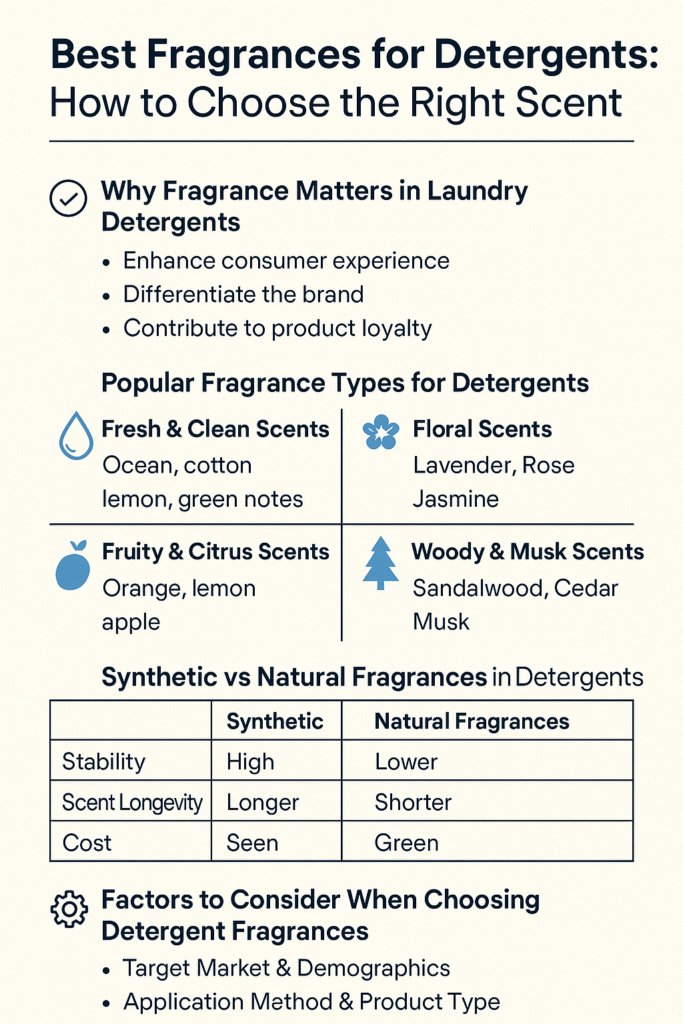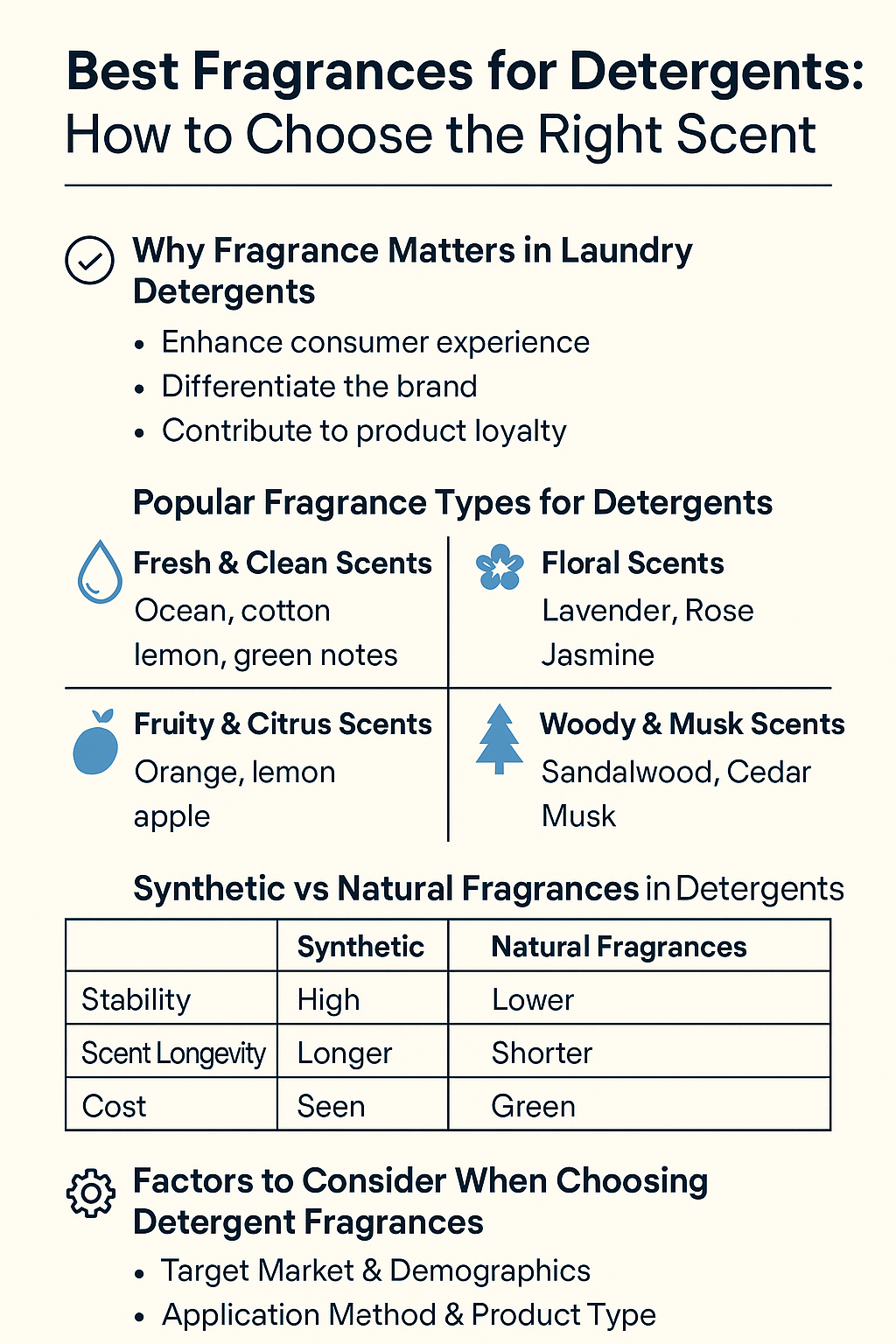洗涤剂的最佳香味:如何选择合适的香味
🧺 洗涤剂的最佳香味:如何选择合适的香味
When consumers buy laundry detergents, one factor consistently ranks among the top: fragrance. The right scent doesn’t just clean clothes—it enhances brand loyalty, evokes emotional comfort, and even shapes perceptions of cleanliness.
But with so many scent options, how do formulators, brands, and manufacturers choose the ideal fragrance? Let’s explore the most popular fragrance types for detergents, how to choose the right one for your product, and key industry trends in 2025.
🌿 Why Fragrance Matters in Detergents
Fragrance is more than just a pleasant aroma. It plays a critical role in:
- Consumer experience: Clean-smelling clothes signal freshness and hygiene.
- Brand identity: Signature scents help build recognition and differentiation.
- Emotional impact: Certain aromas trigger comfort, energy, or even nostalgia.
💡 According to Nielsen, more than 65% of detergent buyers say fragrance is a primary reason for brand selection.
🌸 Popular Fragrance Types for Detergents
The most effective detergent fragrances are clean, fresh, long-lasting, and widely accepted. Here are the top categories:
🧼 Fresh & Clean Scents
These include linen, ocean breeze, powdery cotton, rain, and citrus. They offer a universally accepted, “clean” olfactory signature—ideal for mass-market products.
🌼 Floral Scents
Lavender, jasmine, rose, lily, and peony bring softness and sophistication. They’re popular for feminine-focused products or fabric softeners.
🍋 Fruity & Citrus Scents
Think orange zest, lemon, apple, grapefruit. These fragrances feel energizing and are common in youth- or family-oriented detergents.
🌲 Woody & Musk Scents
Sandalwood, cedarwood, white musk, and amber create a warm, comforting scent. Often used in “premium,” “for men,” or winter-themed products.
🧪 Synthetic vs Natural Fragrances: What’s Better for Detergents?
| 属性 | Synthetic Fragrances | Natural Fragrances |
|---|---|---|
| 资料来源 | Chemically synthesized | Derived from plants or animals |
| 稳定性 | Highly stable under heat, pH, wash | May degrade or oxidize |
| Longevity | Superior lasting power | More subtle, less persistent |
| Cost | Lower and more scalable | Higher and resource-dependent |
| Regulatory | Must meet IFRA compliance | May still trigger allergens |
| Market Appeal | “Safe & functional” image | “Green & clean-label” image |
✅ 结论: Most detergent brands use synthetic or hybrid fragrances to ensure stability, cost-efficiency, and fragrance longevity.
🛠️ Factors to Consider When Choosing Detergent Fragrances
1. Target Audience
- Young families prefer fruity or citrus.
- Older demographics prefer floral or musk.
- Eco-conscious users may demand natural or allergen-free formulations.
2. Product Type
- Powder detergents may need stronger scents to withstand heat.
- Liquid detergents support a wider fragrance profile.
- Laundry capsules or pods often use microencapsulation to enhance longevity.
3. Performance Requirements
- Fragrance must survive washing and drying cycles.
- Must not interfere with surfactants or enzymes.
- Encapsulation technologies can prolong release.
4. Regulatory & Allergen Concerns
- Must comply with IFRA guidelines and local regulations.
- Common fragrance allergens like limonene 和 linalool must be declared when above threshold.
📈 Trending Detergent Fragrances for 2025
Modern consumers want multi-sensory experiences, not just “clean”:
- Yuzu & Green Tea – a clean, exotic citrus profile
- White Tea & Bamboo – minimalist, spa-inspired freshness
- Cotton Flower & Amber – soft, nostalgic, powdery-clean
- Water Lily & Sea Minerals – aquatic, airy, and gender-neutral
- Apple Blossom & Vanilla – comforting and family-friendly
These fragrances are often described as “clean,” “safe,” “natural-inspired,” 和 “long-lasting.”
🧪 How to Test Fragrances in Detergents
- pH and Temperature Stability Testing
- Test how the scent performs in actual detergent formulas.
- Consumer Panel Evaluation
- Blind test multiple variants for likability, intensity, and “freshness.”
- After-wash Longevity Trial
- Wash and dry textiles, then evaluate lingering scent at intervals (1h, 6h, 24h).
- Allergen & Sensitivity Screening
- Run patch tests or in-vitro assays to check for irritation potential.
🌍 Sustainability & Clean-Label Demands
As the clean beauty and green home movement grows, detergent fragrances face scrutiny. Here’s what’s trending:
- Biodegradable fragrance bases
- Vegan-certified or cruelty-free claims
- Fragrance-free or sensitive-skin options
- Microencapsulated essential oils
Brands like Seventh Generation, Method, and Persil are offering transparent fragrance sourcing and disclosure to build consumer trust.
✅ Conclusion: The Right Fragrance Can Define Your Brand
A detergent’s scent is more than an accessory—it’s a strategic decision. Whether you’re formulating for budget-conscious users or premium eco shoppers, the fragrance you choose should align with your performance, perception, and positioning.
Choose wisely, test carefully, and let the right scent do more than clean—it should delight, retain, and differentiate.

